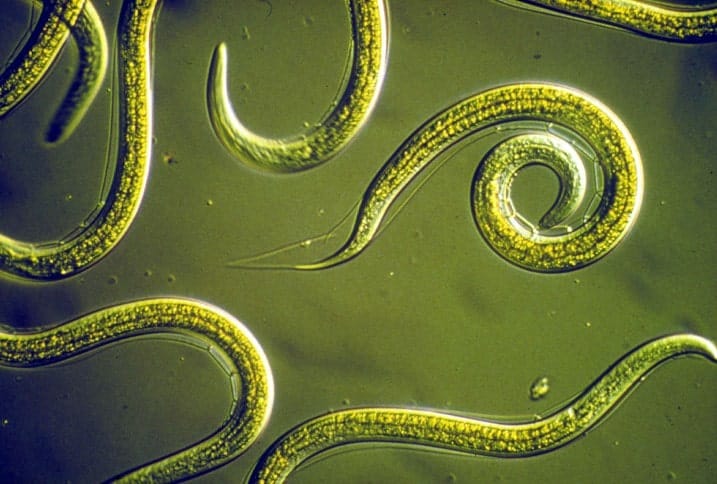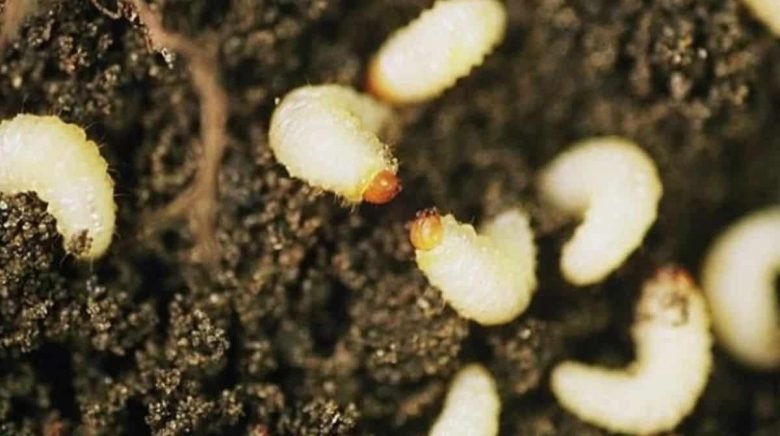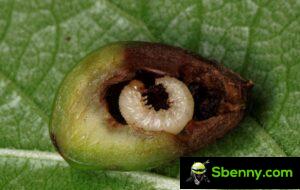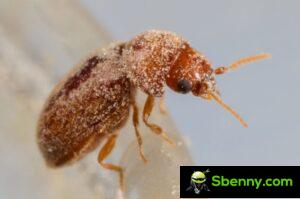THE entomopathogenic nematodes they are gods “beneficial” nematodes for garden plants, whose dimensions are very small. These are tiny “worms” that are used for biological control of parasites in the vegetable garden and fruit trees, and are so small as to be invisible to the naked eye. However, despite being small, they are very effective in eliminating the larvae of numerous species of harmful insects. These particular worm-like organisms act in a very selective way, so they are not harmful to the environment, crops, humans, fish and, in general, animals. Their use is having excellent results in the field, so much so that they are considered an excellent alternative to the use of chemical pesticides.
In this article we therefore try to understand what these particular macroorganisms are, how they behave and how they are used.
What are entomopathogenic nematodes?

Entomopathogenic nematodes under the microscope
Nematodes in nature are classified as a Phylum (type) of the animal kingdom, to which they belong over 20,000 species. These are microscopic “worms”, visible under the electron microscope, which usually behave like parasites. Many of them are harmful parasites, for animals, humans and plants. In fact, we have already told you about crop nematodes, which cause serious deterioration of the root system of plants. However, there are some kinds of nematodes, called entomopathogens, which carry out their parasitic activity against insects which are in turn considered crop parasites. For agricultural purposes they are “good” parasites, that is, they can be used in biological control and are absolutely not harmful to man and the environment. The kinds that can be used in agriculture are: Steinernema And Heterorhabditisspecifically the species: Steinenernema feltiae, S. carpocapsae, S. kraussei, Heterorahabditis bacteriophora And H. megidis.
Against which parasites are entomopathogenic nematodes used?
Entomopathogenic nematodes are obligate parasites of insects in the larval stage, including: beetles, lepidoptera, diptera and hymenoptera. The adult and pupal stages cannot be parasitized by these organisms. Many of the insect species of major agricultural interest against which these nematodes are effective live in the larval stage inside plants (or in the soil). Here they tunnel and feed, thereby causing severe damage to affected crops. Among these we mention:
How entomopathogenic nematodes work

Entomopathogenic nematodes host bacteria from genera within them Xenorhabdus And Photorhabdus. It is these bacteria that in turn parasitize the larvae of harmful insects. In practice, the nematode is a tiny worm, which penetrates inside the target insect. Once inside, it releases these bacteria, which multiply in a short time and kill the host within 24-72 hours of penetration. The entomopathogenic nematode, on the other hand, continues to survive, searching for other larvae to parasitize.
Conditions necessary for them to be effective
Entomopathogenic nematodes need to move in a very humid environment to be effective. Too low temperatures or exposure to the sun’s rays instead cause death. For this, they are administered on crops and in the soil together with water, always maintaining high levels of humidity.
Where they are found are entomopathogenic nematodes
Entomopathogenic nematodes do easily found on the market (for example here) and can be purchased without license, not being classified as pesticides. I am therefore allowed in organic farming. The manufacturing companies generally distribute them in special refrigerated polystyrene containers, so as to guarantee the survival of the macro-organism, which, as mentioned, does not resist high temperatures. On sale there are formulations consisting of a dehydrated soft mass, in an inert substrate (clay, alginate or gel). These substrates contain billions of entomopathogenic nematodes which are reactivated by contact with water. In practice, as mentioned, they are added to the water and the solution is mixed slowly and constantly. This is then distributed on the ground or on the vegetation.
How to use them
In the ground
When sprayed into the soil, they are able to reach the insect larvae that spend stages of development in the soil or in the root system. We are talking in particular of beetles such as the woodruff, the capnodio or the oziorrinco. Nematodes exploit the same entry routes created by insects, such as the tunnels dug in the underground organs of trees.
Another way of entry from the ground is through the rotten fruits that have fallen to the ground, for example apples affected by bewilderment.
On the vegetation
A similar mechanism occurs with the treatment based on nematodes on vegetation. These can be sprayed on the trunk and, if so, are able to reach the wintering insect larvae that nest in the bark. On horticultural crops they do not penetrate directly into the plant tissues of plants, they are unable to. They always exploit the damage already caused by insects, such as the tunnels of a miner parasite such as the tomato absoluta suit. For an optimal success of the intervention, the vegetation must be wet well, until it drips.
Application tips
The treatments, both on the ground and on the vegetation, are always carried out in the cool hours of the day, when it is easier to keep the humidity high. One is used for foliar spraying shoulder pump (like this one), tool able to wet the plants evenly. For soil wetting, even a simple watering can is enough. In this second case, the advice is to keep the soil moist even after the nematode distribution, therefore irrigating often. By doing so, the survival of the nematodes themselves is ensured.
As is obvious, to target parasites in the larval stages (better if young) it is necessary to study and know their life cycle, which is not always easy. Often we only notice an insect when we see it as an adult, even if in reality it is the larvae that cause disasters. A striking example is the red palm weevil.







Start a new Thread